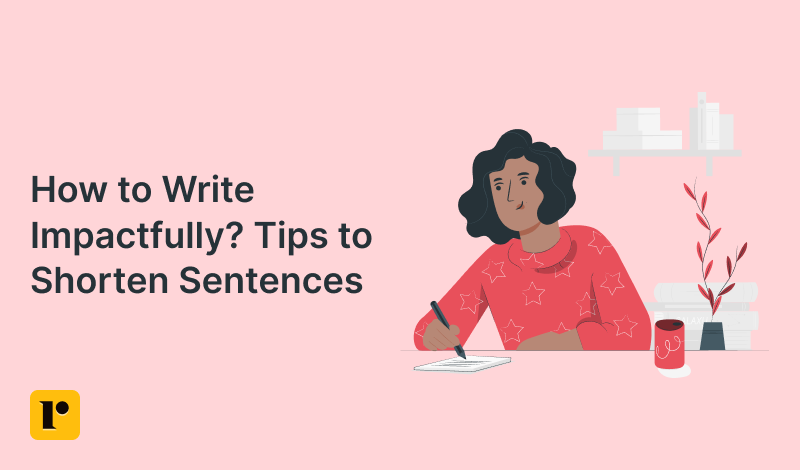
No matter what type of content you write, it should be valuable and impactful. Content that doesn’t serve a purpose is entirely useless. Therefore, as a writer, you must ensure your words hit harder and positively impact readers.
However, writing meaningful content isn’t everyone’s cup of tea. Many find it challenging to communicate effectively, particularly to persuade readers.
Do you want to craft compelling content? If so, learn the art of writing short sentences. Short and crisp sentences grab attention. Also, they convey information without unnecessary fluff. Unsure how to write short sentences? We're here to help. Here, we will share some practical tips for writing short yet influential sentences.
Let’s get started!
Want to condense text instantly? Online tools can help. You can use an online text summarizer to condense long passages. It will highlight key points, cut unnecessary words, and make your text crisp and shorter.
Choose a summarizer with advanced algorithms for accurate results. It will help you summarize your work and make it more impactful.
Do you know what’s the biggest enemy of concise writing? It’s redundancy. Redundancy is saying or writing the same thing multiple times.
For example, “She nodded her head in agreement.” Here, “her head” is unnecessary. Nodding implies the head. So, there is no need to write it. Just say, “She nodded,” it will communicate the message.
Many authors use this practice to improve their content. For instance, George Orwell writes, “If it is possible to cut a word out, always cut it out.” You should also use this practice to polish your sentences.
Eliminating redundancy can enhance your message. It will also keep readers engaged and boost their reading experience.
Don’t use five words where one can convey the same message. Doing so will only expand your sentence, not the message. Therefore, avoid using longer phrases whose simpler and shorter alternatives are available. Simply use the sentence shortener if needed.
For instance, phrases like “due to the fact” are wordy. Instead of writing them, just write “because.” It reflects the same thing. Similarly, “In that event” becomes “if.” “At this point” is just “now.”
Check these phrases during the writing process and when you proofread them. Scan your writing for extended phrases. Find a single word that means the same thing. Swap them. Eventually, your writing will feel lighter and faster.
Weak verbs need help. They rely on adverbs or extra words, while strong verbs stand alone. Therefore, make sure to use strong verbs instead of their weaker alternatives.
For example, write “She strolled” instead of “She walked slowly.”
Strong verbs paint a clear picture, and they’re specific. They also make your writing lively and pull readers in. When you find a weak verb in your content, instantly replace it with a stronger one.
The active voice is direct and reflects who the subject is. Moreover, it’s easy to understand.
For example, “I read Animal Farm” is active, while “Animal Farm was read by me.” is passive.
The active voice is shorter, direct, and stronger. Whereas the passive voice version is wordy, confusing, and less impactful. There are tons of examples of such scenarios.
Passive voice often adds extra words. It can also feel vague. Who’s doing the action? Active voice makes it clear.
George Orwell also writes, “Never use the passive where you can use the active.” To spot passive voice, look for “by” in your sentences. If you see it, you might be using passive voice. Reword it to make the subject the doer.
Some words don’t add value. They only enhance the word count. For instance, words like “very,” “really,” “just,” and “actually” often clutter sentences. Avoid using these words in your content.
However, you need to boost your vocabulary to remove these words and convey your message. Otherwise, you might struggle to communicate your thoughts.
If you have enough words in your vocabulary bank, you won’t find any struggle cutting unnecessary words. For example, you can transform “She was very happy” to “She was thrilled.”
Similarly, you can replace “He ran quickly” with “He sprinted.”
Filler enhances the word count without adding value to the context. Words like “In order to,” “there is,” and “basically” are common examples of filler words. Don’t use many filler words in your content. They won’t help you achieve any goals.
Instead, they will make the text dull and ruin the reading experience.
Transitions connect ideas. But they don’t need to be long, especially when you have their shorter alternatives. Transition words like “however,” “therefore,” and “meanwhile” work well. So, use them as transitions.
Avoid phrases like “on the other hand” or “in addition to the fact that.” They’re wordy and ruin content flow. Always keep transitions short and clear.
Short sentences pack a punch. They’re clear, direct, and engaging. But shortening sentences isn’t about cutting words randomly. It’s about being intentional.
To write powerful content, start by eliminating redundancy. Then, replace phrases with single words and write in the active voice. Cut unnecessary words, use strong verbs, remove filler words, use concise transitions, and leverage tools to help.
Practice these tips, and your writing will improve gradually. Remember, great writing isn’t about length. It’s about meaning. Say what you need to say. Say it well. Say it briefly.